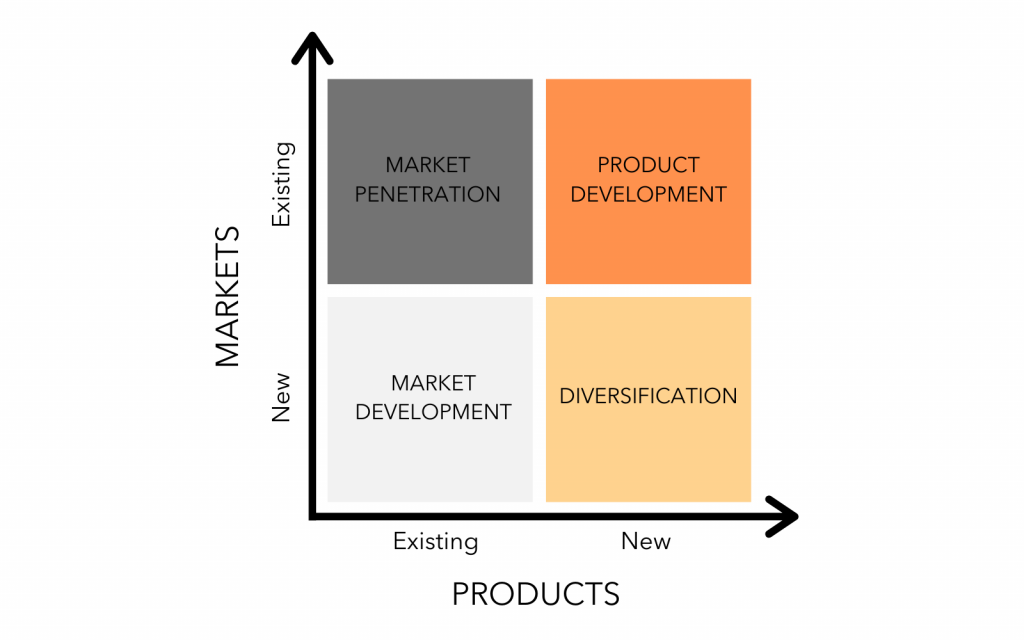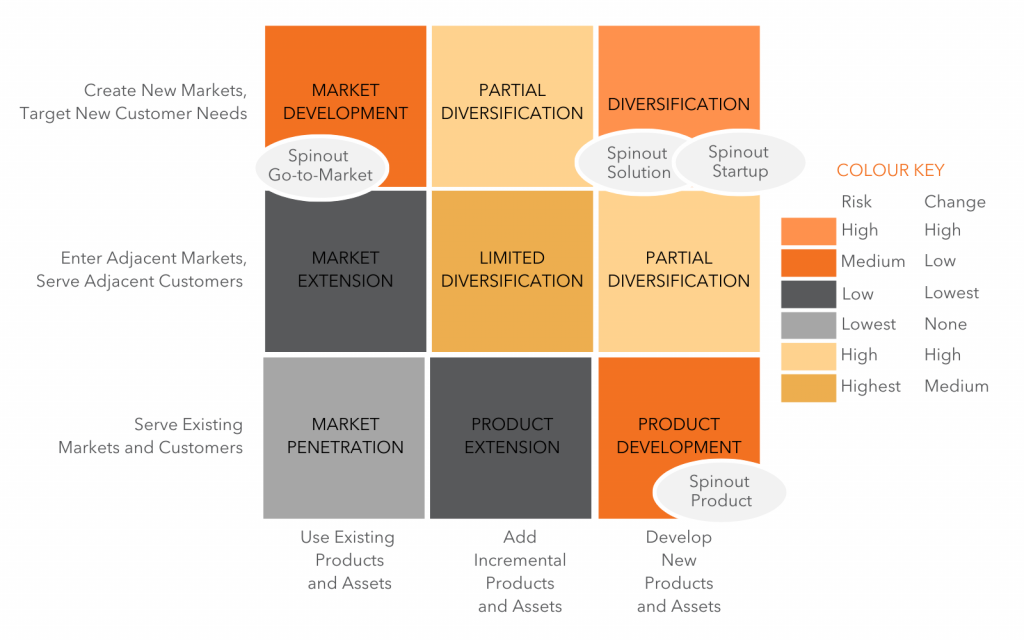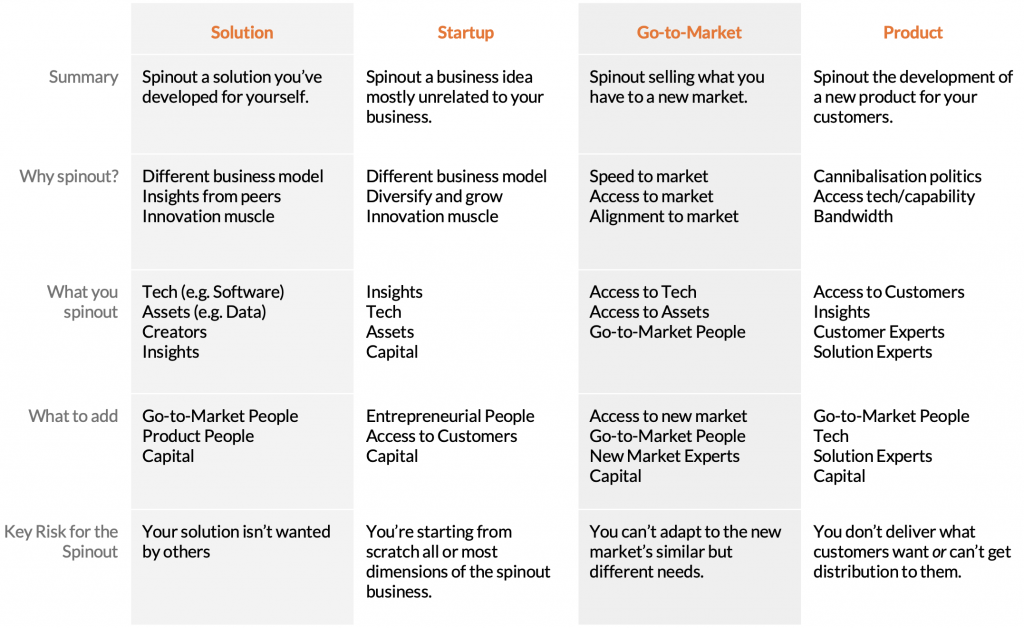Spinouts can be an exciting opportunity for growth. However, there often isn’t clarity on where they fit strategically, yet clarity is essential for getting the new spinout business off and running.
The starting point for gaining clarity is to step back and understand the strategic choices businesses have to grow more generally. Understanding the parent company’s strategic choices for how it will grow allows you to frame the spinout in terms that the parent will understand.
When aiming to grow, businesses have a set of generic strategic choices. The Ansoff Matrix, developed by Igor Ansoff and first published in the Harvard Business Review, provides a quick and simple way of considering growth and growth’s associated risks.

The lower left is the safest of four options, focusing on customers you know and products you already have. The riskiest is selling to customers or needs you don’t understand with a product you need to develop.
While the Ansoff Matrix doesn’t take into account external factors, like increased competition, disruption or slowing growth in your existing market, it gives us a starting point to reason about growth.
Expanding the Ansoff Matrix out and overlaying where spinouts make the most sense, you can now see where spinouts can help drive growth for an established company along with the relative risk and change required:

Additionally, different strategic drivers lead to different types of spinouts:
- A Solution Spinout provides an established business with a way to diversify by commercialising a solution it has developed for itself.
- A Startup Spinout provides an established business with a way to diversify using its capital.
- A Go-to-Market Spinout provides an established business with a way of pursuing new markets and customer needs with existing products.
- A Product Spinout provides an established business with a way to develop a new product for its existing customers.
Considering spinouts in this way helps guide the conversation internally about the spinout. For example, before asking, “do we spinout?” you want to ask, “do we want to diversify?” or “do we want to grow into a new market?”. Once these are answered, you can be more specific about the options you have – of which spinout is just one – to pursue that type of growth.
Spinouts can also be a mechanism for divesting underperforming assets or assets that no longer fit the strategy, but this type of spinout is not the focus of this article.
Types of Spinouts
Now let’s go through the types of spinouts and some of the key attributes.

Some notes on the above table:
- Why spinout: the reasons listed in the table are the most compelling reasons that are specific to this type of spinout. There are reasons for spinning out that are common across each type (e.g. grow revenue, increase enterprise value, speed, focus, flexibility), but these are beyond the scope of this article.
- What you spinout: are the key things you need to put into the new business.
- What to add: the key things you need to add to the spinout that you likely don’t have in house.
- Key risk: the primary risk the spinout faces.
1. Solution Spinout
In this situation, a company has usually developed a solution for itself that it believes could be sold to other companies like it. The solution itself is to be spun out and commercialised.
For example, IAG and Terem Joint Ventures spun out the Attune solution that IAG had developed to enable flexible working in its contact centres.
2. Startup Spinout
This type of spinout is where an established company creates a standalone business tasked with pursuing new customers with a new product or service. You’re almost pursuing a regular startup venture.
These are the most challenging to work through because, unless you can leverage an asset or distribution channel, you’re almost starting from behind compared to a standard venture-backed startup. Startups can access capital and bring reputation to the same extent that an established business can.
Often these are better candidates for your Corporate Venture Capital team than a spinout.
3. Go-to-Market Spinout
A Go-to-Market Spinout lets you more discreetly pursue new markets with the products and services you have. Given the spinout’s independence, it can focus more specifically on the differences, no matter how nuanced, in the new market.
For example, US fintech Acornz spun out Raiz, listing Raiz on the Australian Stock Exchange, to pursue the Australian market. This allowed Raiz to focus on Australian regulation and the dynamics of the Australian market, such as catering explicitly to Australia’s superannuation system, which differs from the United States retirement savings system.
The spinout must address the differences to succeed whereas, if the go-to-market were part of the parent, then the differences might be overlooked by head office. Ford famously ran a campaign that when translated from English to Dutch promoted that everyone needs a car with a “high-quality corpse” instead of a “high-quality body”.
4. Product Spinout
You may see an opportunity to grow by offering a new product to your existing customers. You create a standalone business with some links back, tasked with developing and commercialising the new product. The parent hopefully helps distribute and market the product.
Spinning out, especially in the form of a joint venture, can get you access to new technology or capabilities. Spinning out may also help fight the cannibalisation battle in that, if cannibalisation of your existing business will occur, spinning out helps protect your efforts from being squashed by existing business units and politics.
For example, a $100bn bank spun out a white label payment gateway business, mx51, in order to provide a better payment gateway to its customers, as well as be able to respond faster and better to the changes in the market.
Keep reading about spinouts:

Scott Middleton
CEO & Founder
Scott has been involved in the launch and growth of 61+ products and has published over 120 articles and videos that have been viewed over 120,000 times. Terem’s product development and strategy arm, builds and takes clients tech products to market, while the joint venture arm focuses on building tech spinouts in partnership with market leaders.
Twitter: @scottmiddleton
LinkedIn: linkedin.com/in/scottmiddleton